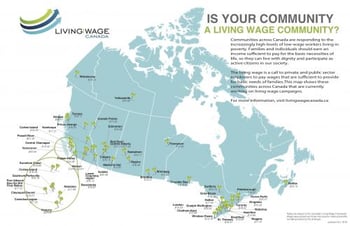October 31st - November 6th marks the annual Living Wage Week in Canada for 2016.

This is a week where living wage organizers celebrate employers in their role of providing staff with liveable wages, and support them to raise awareness about what a living wage is, as well as the benefits of paying one.
There are now living wage rates calculated in 53 communities across Canada. Of which, 26 are linked to Cities Reducing Poverty comprehensive poverty reduction initiatives, an increase of five in the past year, with even more communities in the process of researching or developing a living wage campaign.
Living wage is a strategy and policy area that Vibrant Communities Canada is studying as an Income and Employment 'Game Changer' in poverty reduction (send us your thoughts on Game Changers via twitter, using the hashtag #PRgamechanger).
Some of the positive, cascading impacts or outcomes of a living wage, beyond tangible financial assets for workers and their families, include that it:
- Provides a dignified approach to ensuring people have the means to live free from poverty, moving us from a charitable to a justice-focused or rights-centred mindset.
- Increases wealth in the community, acting as a lever for local economic development. We know that people on low-income are more likely to put money back into the economy when given the means.[1]
- Engages businesses as core stakeholders and can provide alternative roles for them to be involved in poverty reduction. For instance, one employer used their talent to create and run a living wage advertisement in the local movie theatre throughout the summer.
- Moves the needle forward on decent work. We see there is a positive correlation between introducing living wages and investment in positive working conditions - such as training - for employees.
- Engages the broader public in a discussion on the real cost of living in the community, versus the standard of living that minimum wage and social assistance afford. This can be especially important for those initiatives aiming to educate and shift attitudes about people living in poverty as a core priority.
As we are approaching the next annual national poverty reduction summit, entitled 'When Business Is Engaged', let's take a better look at the third point. The living wage experience in Canada has developed with a voluntary approach to implementing liveable wages. Employers are engaged in discussion of the benefits of paying a living wage, gaining support and buy-in for the implementation of living wage rates. This makes the employer - in the non-profit, municipal/public, and for-profit sectors - key stakeholders, and often leaders in living wage initiatives.
Beyond paying employees living wages, for-profit employers are contributing to the growing living wage movement by using the assets that are unique to their company, industry, and/or sector to:
- Act as living wage champions. For-profit employers are facilitating similar productive conversations with other employers by talking peer-to-peer about the benefits of paying a living wage, from a place of understanding and experience. This helps establish credibility and communicates the living wage in terms that are more accessible to businesses. This works especially well when employers share best practices and successful approaches with one another.
Examples:- McMaster University's Degroote School of Business is a local anchor institution, and through research discussions, has increased the credibility of the living wage within the business community.
- Vancity acts as a champion in Vancouver, across British Columbia, and attends events across Canada to share their living wage experience with other employers.
- Build on the conversation and the case for a living wage. For-profit employers in the room and at the core table help broaden the conversation. It's not helpful to have poverty reduction organizers always talking to other like-minded people. For-profit employers challenge our assumptions and provide another perspective on the barriers and opportunities of the living wage.
 Provide expertise in marketing and expand your reach. Businesses are proud of the role they play as living wage employers. They generally see the benefit in sharing the good news, and marketing and communications are essential skills that most businesses possess. Consider how employers can mobilize their own networks and communication resources to help promote the living wage:
Provide expertise in marketing and expand your reach. Businesses are proud of the role they play as living wage employers. They generally see the benefit in sharing the good news, and marketing and communications are essential skills that most businesses possess. Consider how employers can mobilize their own networks and communication resources to help promote the living wage:
- Making the living wage a front-and-centre issue by displaying window decals in a well-trafficked area.
- Using their social media accounts to talk widely about being a living wage employer and sharing employee perspectives.
- Acting as partners to organize events and manage event communications. (Ex. Windsor-Essex Chamber of Commerce).
- Create and run advertisements or marketing campaigns amongst their target audience(s).
- Spirit and energy that leads to action. The for-profit sector's activities are based in risk-taking principles. Businesses often bring the 'let's try, and see' attitude to poverty reduction initiatives, which can be an essential extra push for groups.
What are some of the creative ways that employers are stepping up and taking leadership in your living wage community? Help us expand the conversation by telling us over social media, using the hashtag #livingwage or tag @livingwageCDA.

You are interested in the living wage. What next?
Looking to engage employers?
- Watch the webinar with Deanna Ogle, A Living Wage for Families, and Catherine Ludgate, Vancity
- Hear from Mike Kelly, KPMG London, on engaging employers from the business perspective
- Find the business case for paying a living wage
See the living wage momentum growing through news stories over the past year:
- Municipalities coming aboard as living wage employers and champions
- Vancouver City Council takes important steps towards implementing a living wage
- Port Coquitlam's City Council unanimously votes to adopt a living wage policy
- Quesnel, BC becomes the second municipality in Canada to implement a living wage policy
- City of Parksville becomes 4th in BC to commit to a living wage policy
- City of Cambridge to become first living wage municipality in Ontario

Canadian Living Wage Week News, 2016:
- Windsor-Essex, Guelph-Wellington (celebrating 11 new employers), Waterloo Region, and Saskatoon celebrate employers by hosting recognition events
- CCPA Ontario releases living wage week podcast trio
- Episode 1 - Tom Cooper and Greg deGroote Maggetti, advocates with the regional Ontario Living Wage Network
- Episode 2 - Helmi Ansari and Kelly Watson, living wage employers with Grosce and Muskoka Brewery
- Episode 3 - Diedre Pike and Cam Jay, local organizers with the Social Planning and Research Council of Hamilton and Anti-Poverty Kingston
[1] Also see The Federal Reserve Bank of Chicago's report How does a federal minimum wage hike affect aggregate household spending? August 2013, Number 313.





